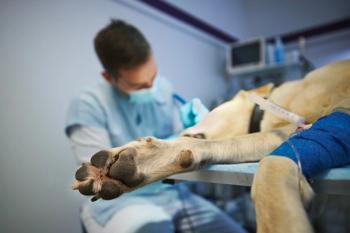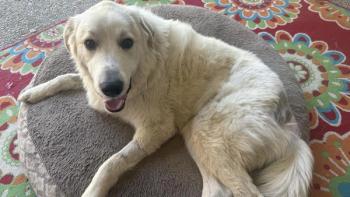
- Vetted April 2020
- Volume 115
- Issue 4
MRI patterns help identify Chiari-like malformation in dogs
A recent study shows that analyzing the whole skull versus just the hindbrain in brachycephalic breeds would allow earlier diagnosis of Chiari-like malformation and syringomyeliakey to reducing the amount of pain a dog is in.
Why they did it
Chiari-like malformation (CM) is a common developmental malformation of the skull and craniocervical vertebrae in several breeds of dogs, especially the Cavalier King Charles spaniel. Dogs with CM have a mismatch between the size of the brain and the skull, particularly at the craniospinal junction. CM is the most common cause of canine syringomyelia, which is characterized by fluid-filled cavities within the central spinal cord. These “syrinx” or “syringes” can cause neurologic damage that results in pain and clinical signs.
Diagnosis of CM/syringomyelia in dogs is not always straightforward. Cavalier King Charles spaniels with syringomyelia secondary to CM can have a range of conformation anomalies. Additionally, syringomyelia is not always associated with clinical signs and dogs with CM alone can exhibit signs of pain. Unrelated conditions are also common in breeds predisposed to CM/syringomyelia. Historically, diagnosing CM/syringomyelia early or accurately has been a challenge for veterinarians.
Studies aimed at facilitating diagnosis have examined the rostral cranial cavity and craniocervical junction. The
What they did
A retrospective review of 206 King Charles Cavalier spaniels that presented for neurologic pain or pre-breeding CM/syringomyelia screening between 2013 and 2017 was conducted. Inclusion required having been evaluated by weighted MRI images of the cervical spinal cord and head, including the nasal cavity. Age at MRI, final diagnosis, clinical and behavioral signs of pain, and maximum transverse diameter of the central canal dilation or syrinx (if present) were evaluated. Dogs were excluded if images did not include the rostral head or if the diagnosis was equivocal; for example, if an alternative explanation of pain was identified or if the patient was younger than 4 years of age, as syringomyelia is typically a late-onset disease. Dogs with a milder syringomyelia phenotype (transverse width of 2-3.99 mm) were also removed, as a previous study has suggested that specific clinical signs associated with SM are seen in dogs with a syringomyelia transverse width of four mm or more. Sixty-six dogs (32 females, 34 males) were identified, of which 40 dogs had syringomyelia and 26 did not. Excluded from the study were 140 dogs.
After identification of the study cohort, all of the MRI images were anonymized and randomized. The study cohort was subsequently divided into three clinical groups for statistical analysis:
- Group 1 (control group): dogs with CM that were otherwise clinically normal (n = 11)
- Group 2: dogs with CM and pain (n = 15)
- Group 3: dogs with CM with syringomyelia-specific clinical signs (n = 40)
Because the study aim was broad, morphometric mapping was divided into two separate studies, one focusing on anatomic features relating to the soft palate and the other on anatomic features relating to the hard palate. Using machine learning and two imaging software packages, orofacial structures involving the hard and soft palates with respect to CM and syringomyelia were measured.
What they found
Machine learning identified the floor of the third ventricle, nearby neural tissue and a region in the sphenoid bone as biomarkers for CM pain. It found that the presphenoid bone and the region between the tongue and soft palate are biomarkers for syringomyelia.
Dogs with clinically relevant CM/syringomyelia were more likely to have brachycephalic features of rostral skull flattening with reduction of nasal tissue and a well-defined stop. In dogs, the stop is the degree of angle change between an animal's skull and the nasal bone near the eyes.
Take-home message
This research characterized differences in MRI images of healthy dogs from those with clinical signs of pain associated with CM and syringomyelia. This study suggests that the whole skull should be analyzed when diagnostic testing or pre-breeding screening is performed. Doing so has implications for breeders and would allow for earlier diagnosis and implementation of pain management strategies. This research also demonstrates the exciting potential of machine learning techniques to be applied to a variety of breeds and diseases.
References
1. Knowler SP, Dumas E, Spiteri M, et al. Facial changes related to brachycephaly in Cavalier King Charles Spaniels with Chiari-like malformation associated pain and secondary syringomyelia. J Vet Intern Med 2019;1-10.
2. Rusbridge C, McFadyen AK, Knowler SP. Behavioral and clinical signs of Chiari-like malformation-associated pain and syringomyelia in Cavalier King Charles spaniels. J Vet Intern Med 2019;33(5):2138-2150.
3. Spiteri M, Knowler SP, Rusbridge C, et al. Using machine learning to understand neuromorphological change and image-based biomarker identification in Cavalier King Charles spaniels with Chiari-like malformation-associated pain and syringomyelia. J Vet Intern Med 2019;33(6):2665-2674.
Dr. Joan Capuzzi is a small animal veterinarian and journalist based in the Philadelphia area.
Articles in this issue
over 5 years ago
Winning advice for veterinary hospital designover 5 years ago
The pros and cons of veterinary wellness plansover 5 years ago
Tickborne disease surveillance: An adaptive approachalmost 6 years ago
Journal Scan: Punitive training makes dogs pessimisticabout 6 years ago
What to know before you buy a veterinary clinicabout 6 years ago
Veterinary dental extractions: Three critical factorsover 6 years ago
Nutritional management of chronic kidney diseasealmost 7 years ago
Journal Scan: Given the choice, what diet would a pet choose?Newsletter
From exam room tips to practice management insights, get trusted veterinary news delivered straight to your inbox—subscribe to dvm360.






